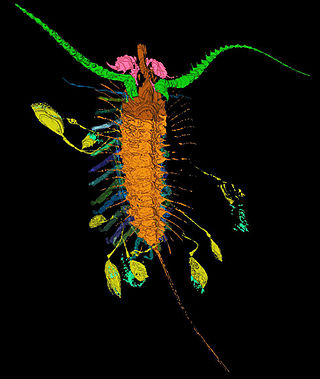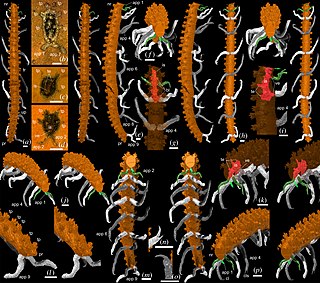
Ostracods, or ostracodes, are a class of the Crustacea, sometimes known as seed shrimp. Some 70,000 species have been identified, grouped into several orders. They are small crustaceans, typically around 1 mm (0.04 in) in size, but varying from 0.2 to 30 mm in the case of Gigantocypris. Their bodies are flattened from side to side and protected by a bivalve-like valve or "shell" made of chitin, calcium carbonate and protein. The hinge of the two valves is in the upper (dorsal) region of the body. Ostracods are grouped together based on gross morphology. While early work indicated the group may not be monophyletic and early molecular phylogeny was ambiguous on this front, recent combined analyses of molecular and morphological data found support for monophyly in analyses with broadest taxon sampling.
Traditionally, the Myodocopa and Podocopa have been classified as subclasses within the class Ostracoda, although there is some question about how closely related the two groups actually are. The Myodocopa are defined by possession of a poorly calcified carapace, and 8–9 articles in the exopod of the second antenna. The ventral margin of the carapace is not concave, and the valves do not overlap to a great extent.

The Pristerognathus Assemblage Zone is a tetrapod assemblage zone or biozone which correlates to the upper Abrahamskraal Formation and lowermost Teekloof Formation, Adelaide Subgroup of the Beaufort Group, a fossiliferous and geologically important geological Group of the Karoo Supergroup in South Africa. The thickest outcrops, reaching not more than 300 metres (980 ft), occur just east of Sutherland through to Beaufort West in the south and Victoria West in the north. Exposures are also found west of Colesberg and south of Graaff-Reinet. The Pristerognathus Assemblage Zone is the third biozone of the Beaufort Group.

Waptia is an extinct genus of arthropod from the Middle Cambrian of North America. It grew to a length of 6.65 cm (3 in), and had a large bivalved carapace and a segmented body terminating into a pair of tail flaps. It was an active swimmer and likely a predator of soft-bodied prey. It is also one of the oldest animals with direct evidence of brood care. Waptia fieldensis is the only species classified under the genus Waptia, and is known from the Burgess Shale Lagerstätte of British Columbia, Canada. Specimens of Waptia are also known from the Spence Shale of Utah, United States.

Chuandianella ovata is an extinct bivalved arthropod that lived during Cambrian Stage 3 of the Early Cambrian. It is the only species classified under the genus Chuandianella. Its fossils were recovered from the Chengjiang Biota in Yunnan, China.

Kunmingella is genus of Cambrian bradoriid from the Chengjiang biota, containing the single species K. douvillei. Kunmingella had 12 appendages, including a pair of antennae as well pairs of biramous limbs, including four anterior pairs of appendages bearing double rows of endites on their endopods, and a posterior 5 with only a single row of endites, as well as two terminal pairs of uniramous limbs. Eggs have been found preserved attached to the posteriormost three pairs of biramous limbs, suggesting it engaged in brood care. Around 50–80 eggs, each around 150–180 μm across were attached in total.

Bradoriida, also called bradoriids, are an extinct order of small marine arthropods with a bivalved carapace, which globally distributed, forming a significant portion of the Cambrian and Early Ordovician soft-bodied communities.
Pauline avibella is a fossil ostracod from the Silurian with unusually well preserved soft parts, including limbs, eyes, gills and alimentary system.
Pauline is a fossil genus of ostracods from the Silurian. Genus contains two species: Pauline avibella found in 425-million-year-old rocks in the Herefordshire Lagerstätte in England near the Welsh Border and Pauline nivisis, known from the Lower Silurian Pentamerus Bjerge Formation of north Greenland.
This list of fossil arthropods described in 2014 is a list of new taxa of trilobites, fossil insects, crustaceans, arachnids and other fossil arthropods of every kind that have been described during the year 2014. The list only includes taxa at the level of genus or species.

Invavita piratica is an extinct, parasitic species of tongue worm, provisionally assigned to the order Cephalobaenida, from Herefordshire Lagerstätte, Ludlow-aged England. It possessed a head, a worm-like body, and two pairs of limbs.

Aquilonifer spinosus is an extinct species of arthropod from the Silurian period. It is known from a single fossil specimen found in the Wenlock Series Lagerstätte of Herefordshire, England, in rocks about 430 million years old. The 1 cm long specimen is a stem-group mandibulate, not directly related to any living species. The many-legged, eyeless adult has ten unusual tethered appendages, interpreted as juveniles attached to the parent, in a unique form and previously unknown brooding behaviour.
This list of fossil arthropods described in 2018 is a list of new taxa of trilobites, fossil insects, crustaceans, arachnids, and other fossil arthropods of every kind that were described during the year 2018, as well as other significant discoveries, and events related to arthropod paleontology that are scheduled to occur in the year 2018.
This list of fossil arthropods described in 2019 is a list of new taxa of trilobites, fossil insects, crustaceans, arachnids and other fossil arthropods of every kind that are scheduled to be described during the year 2019, as well as other significant discoveries and events related to arthropod paleontology that are scheduled to occur in the year 2019.

Hymenocarina is an order of extinct arthropods known from the Cambrian. They possess bivalved carapaces, typically with exposed posteriors. Members of the group are morphologically diverse and had a variety of ecologies, including as filter feeders and as predators. Recent research has generally considered them to be stem or crown group members of Mandibulata, due the presence of mandibles in at least some species.
Luolishania is an extinct genus of lobopodian panarthropod and known from the Lower Cambrian Chiungchussu Formation of the Chengjiang County, Yunnan Province, China. A monotypic genus, it contains one species Luolishania longicruris. It was discovered and described by Hou Xian-Guang and Chen Jun-Yuan in 1989. It is one of the superarmoured Cambrian lobopodians suspected to be either an intermediate form in the origin of velvet worms (Onychophora) or basal to at least Tardigrada and Arthropoda. It is the basis of the family name Luolishaniidae, which also include other related lobopods such as Acinocricus, Collinsium, Facivermis, and Ovatiovermis. Along with Microdictyon, it is the first lobopodian fossil discovered from China.

Thanahita is a genus of extinct lobopodian and known from the middle Silurian Herefordshire Lagerstätte at the England–Wales border in UK. It is monotypic and contains one species, Thanahita distos. Discovered in 2018, it is estimated to have lived around 430 million years ago and is the only known extinct lobopodian in Europe, and the first Silurian lobopodian known worldwide.

Hallucigeniidae is a family of extinct worms belonging to the group Lobopodia that originated during the Cambrian explosion. It is based on the species Hallucigenia sparsa, the fossil of which was discovered by Charles Doolittle Walcott in 1911 from the Burgess Shale of British Columbia. The name Hallucigenia was created by Simon Conway Morris in 1977, from which the family was erected after discoveries of other hallucigeniid worms from other parts of the world. Classification of these lobopods and their retatives are still controversial, and the family consists of at least four genera.

Coalbrookdale Formation, earlier known as Wenlock Shale or Wenlock Shale Formation and also referred to as Herefordshire Lagerstätte in palaeontology, is a fossil-rich deposit (Konservat-Lagerstätte) in Powys and Herefordshire at the England–Wales border in UK. It belongs to the Wenlock Series of the Silurian Period within the Homerian Age. It is known for its well-preserved fossils of various invertebrate animals many of which are in their three-dimensional structures. Some of the fossils are regarded as earliest evidences and evolutionary origin of some of the major groups of modern animals.
Carbotubulus is a genus of extinct worm belonging to the group Lobopodia and known from the Carboniferous Carbondale Formation of the Mazon Creek area in Illinois, US. A monotypic genus, it contains one species Carbotubulus waloszeki. It was discovered and described by Joachim T. Haug, Georg Mayer, Carolin Haug, and Derek E.G. Briggs in 2012. With an age of about 300 million years, it is the first long-legged lobopodian discovered after the period of Cambrian explosion.












